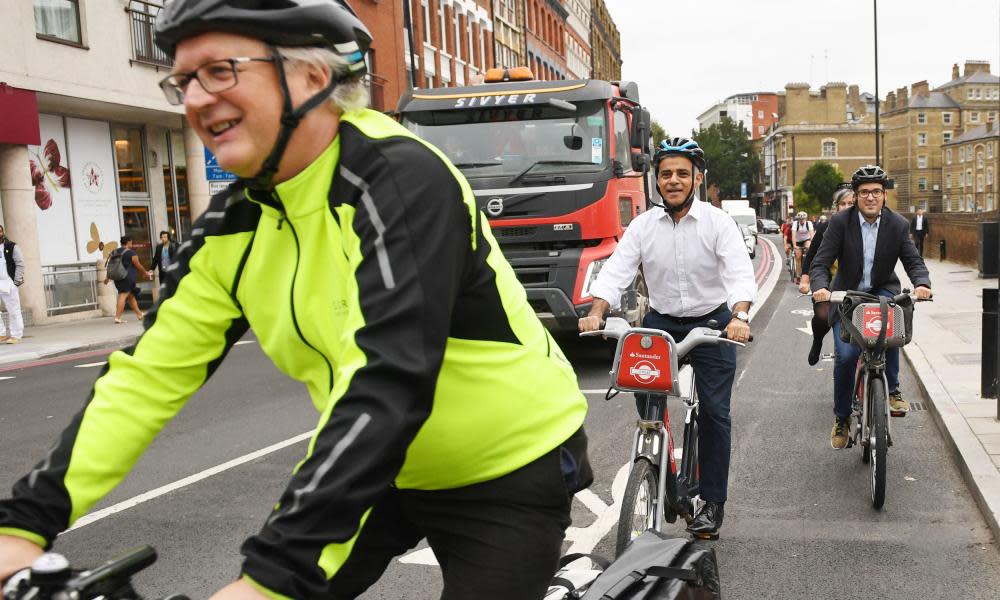Sadiq Khan says he's better than Boris on cycling – but do his claims add up?

On a blustery September day two years into his mayoralty of London, Sadiq Khan appears atop a Santander cycle to open a stretch of kerb-protected bike lane – the 2.5km extension of cycle superhighway 6, from Farringdon to Kings Cross. It may be the first time he’s appeared officially on a bike since his 2016 election campaign but he seems genuinely passionate about cycling and walking, and has clearly done his homework – even if some of his stats don’t tell the whole story.
Flanked by his deputy mayor for transport, Heidi Alexander, and his walking and cycling commissioner, Will Norman, Khan is bullish about his cycling record. This despite ongoing criticism over delays, and a bruising exchange with Westminster city council this summer – the council he brands “anti-walking, anti-cycling” after it blocked cycle superhighway 11 and Oxford Street pedestrianisation in quick succession.
Given the time it’s taken to get this far, many Londoners wonder how he will meet his pre-election pledge to triple to 36 miles the length of protected cycle routes built by his predecessor, Boris Johnson.
With commuters on bikes streaming past on the new cycle tracks and pedestrians using the improved crossings, Khan talks quickly, sweeping away criticism of slow progress.
“In the first two years – you mention the previous guy – we have built 140km of new cycle infrastructure,” says Khan. “This is 5km of a cycle superhighway. It took the previous guy six years to do one mile, so I’m happy to compare myself to Boris all day long.”
Although Khan is correct (he’s counting cycle tracks in both directions), the London Cycling Campaign (LCC) argues he should be averaging out mileage completed in Johnson’s last two years of mayoralty– not least given that most, if not all, of the schemes Khan is counting for himself were started by the previous administration.
Then there’s the fact that about 120km of the routes Khan is claiming, are cycle quietways, some of which are problematic to the point that Johnson’s cycling commissioner, who started them off, has branded the scheme a failure. Although some sections of routes are good, the LCC says “just about every single quietway we have seen has major issues”, from dangerous junctions to high traffic volumes and speeds, because boroughs are unwilling to restrict motor traffic.
CS6 is popular, though, even if imperfect – leaving the main road a couple of times to zig-zag on back streets – and huge numbers of people on bikes accumulate at each phase of the traffic lights. Khan seems to “get” cycling as a viable method of mass transport, and recognises that things need to get moving.
“Look at the evidence”, he says. “The fastest form of transport in London is cycling. In central London there are more than half a million kilometres cycled each day.
“We need to accelerate that progress. We need more people walking and cycling. Why? Our city is growing. It’s not possible in the future for 10 million Londoners to drive across our city – but also the air quality in London is a killer.”
He cites evidence that shows bike lanes are good for local businesses too: “The businesses that thrive and flourish are [those which see] more people walking and cycling, stopping by, having a coffee, stopping to buy something from the shop.
“There’s a health case, there’s a business case, but also, you know what? It’s enjoyable too.”
Behind the scenes, Khan’s team have delivered the mayor’s transport strategy, and a massive restructuring of TfL; they have a new and passionate deputy mayor for transport in Heidi Alexander. Khan has doubled cycling funds compared with the previous mayor, he’s introduced a T-charge, plans to introduce an ultra low emissions zone and next year there will be a permit scheme to start phasing the most dangerous lorries off London’s roads.
Khan knows that boroughs, who control 95% of London’s roads, are crucial in the success or failure of schemes – they have the power to veto schemes they don’t want, even if they have benefits for London as a whole. He talks of working with a “coalition of the willing” – boroughs such as Camden and Islington who helped deliver CS6.
Then there are those who aren’t willing. “We’ve got to work with those who want to work with us, but it is frustrating some councils seem to be anti-walking and cycling,” he says.
“What I’ve said to Westminster is, we’ve spent the last two years working with you, been to many, many meetings, spent millions of pounds working with you, on a scheme you approved. At the 11th hour you did a U-turn; it’s now up to you to come to me with a scheme.”
Khan wouldn’t be drawn on the use of GLA Act powers, that reportedly permit a mayor to seize control of a borough’s roads for strategic schemes, but called on Londoners to put pressure on councils “to do right by our city”.
If they won’t listen to the mayor, perhaps they’ll listen to their voters – or risk voters electing someone who will listen.
In the meantime there’s plenty for his team to get on with.
CS4 got 83% support in consultation almost a year ago. Around the same time CS9 had 59% support in consultation. Khan says they’re working on 25 cycling corridors, and in January City Hall announced six were entering the design stage, although consultations have not yet started. The LCC, among others, has expressed frustration at the long delays between each stage of development.
It’s great to see completion of CS6, and it’s encouraging to see Khan enthused and informed on cycling. But if he wants to succeed, he’ll have to walk the walk – which means stepping up the pace.

 Yahoo News
Yahoo News 
